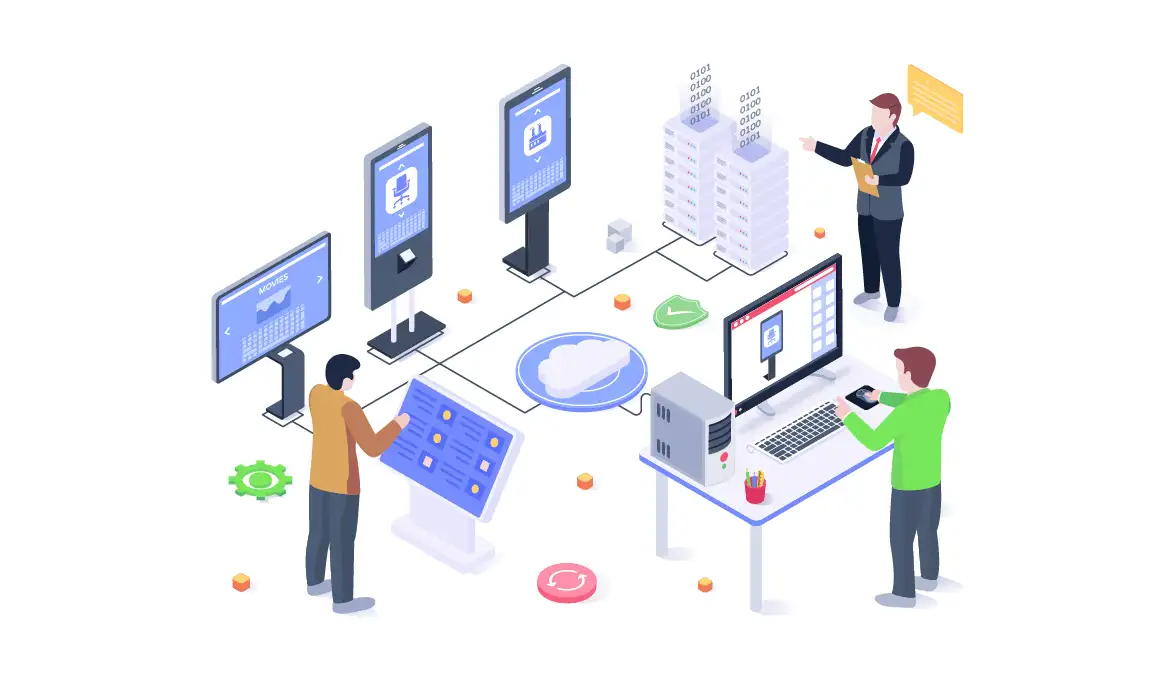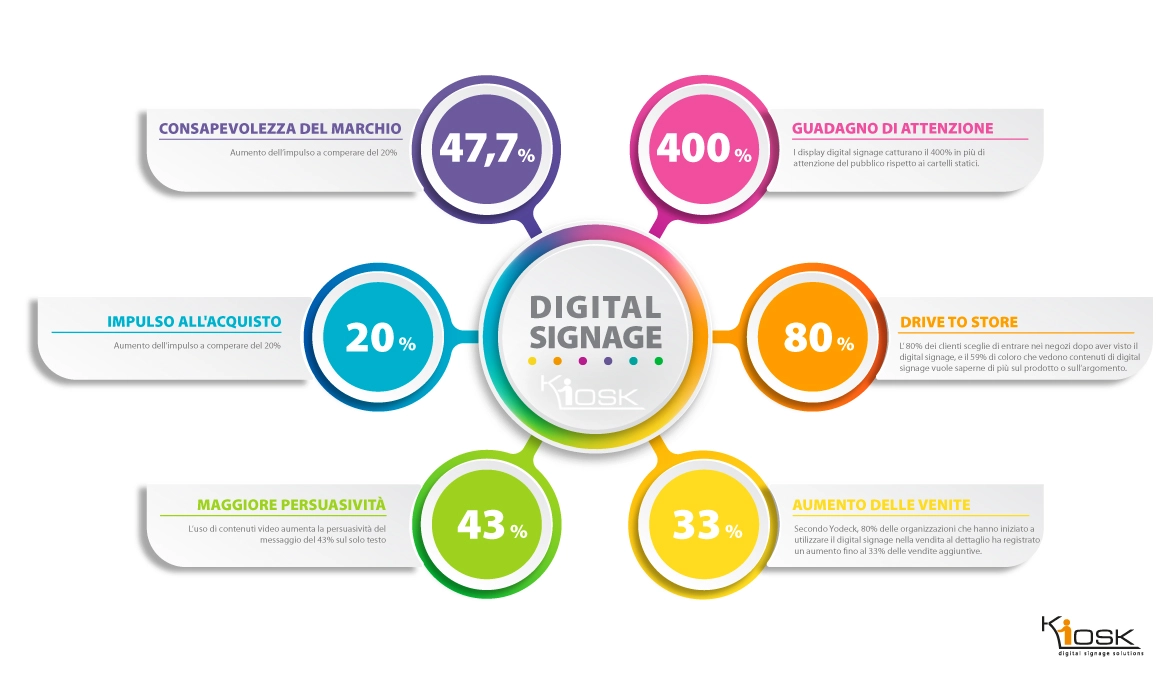The world of communication is experiencing a digital transformation thanks to the diffusion of indoor and outdoor interactive displays and totems. One tool, which is increasingly gaining market interest, is Digital Signage software.
This technological solution allows companies to create, manage and distribute multimedia content on digital screens, offering numerous advantages in terms of visual communication.
Depending on the specifics of the business, there are solutions more oriented towards the management of content on displays, others towards the display and use of interactive content, others more oriented towards the analysis and monitoring of campaign effectiveness, others stronger in the management of remote devices, others to the typical dynamism of advertising.
In this article, we will explore the definition of digital signage software, its benefits and many aspects to consider in classifying and choosing the most suitable solution.
Index
- Definition of Digital Signage Software
- The great Plus of digital signage
- Benefits of Digital Signage Software
- Examples of using Digital Signage software
- Software functionality analysis
- Implement a digital signage communication strategy
- Integration between digital signage software and CRM and ERP software
- The role of digital signage software in the customer experience
- Digital signage performance measurement
- Personalization and targeting in digital signage
- Digital Signage network security
- Scalability and centralized management in Digital Signage software
- Future trends in digital signage software
1 – Definition of digital signage software
Digital Signage software is a computer-based platform that allows businesses to create and distribute multimedia content on digital screens located in public or private places.
These screens can be wall monitors, interactive totems, screens at the entrance to buildings or even screens in cars. The software allows you to schedule and manage content flexibly, allowing you to convey information, promote products, provide guidance and engage your audience in innovative ways.
2 – The great plus of digital signage
The factor that determined the success of digital signage is the ability to bring your well-packaged message to the place and moment in which the purchase decision is made.
The required investment is becoming more accessible every day thanks to the availability of various suppliers who offer solid solutions at a competitive price and with a great return.
But let’s see some data together.
- Digital signage is 47.7% effective on brand awareness.
- Digital signage displays capture 400% more audience attention than static signs.
- According to Yodeck, 80% of organizations that have started using digital signage in retail have seen up to a 33% increase in additional sales.
- According to Yodeck, 80% of organizations that have started using digital signage in retail have seen up to a 33% increase in additional sales.
- Increased impulse to buy by 20%
3 – Benefits of Digital Signage Software
Using Digital Signage software offers many advantages for companies wishing to improve their visual communication.
Here are some of the main benefits:
- Engagement of the public: thanks to the possibility of using images, videos, animations and dynamic texts, Digital Signage immediately captures the attention of the public. This allows companies to engage audiences effectively by delivering clear and persuasive messages.
- Flexibility and real-time updates: Unlike traditional means of communication, such as printed posters, Digital Signage software allows you to update content in real time. This flexibility allows messages to be tailored to specific needs and situations, providing up-to-date and relevant information.
- Message personalization: Digital Signage software offers the ability to personalize content based on the demographic, behavioral or geographical characteristics of the audience. This allows businesses to deliver targeted messages that address the specific needs and preferences of their customers.
- Centralized management: Digital Signage software allows you to centrally manage the content that is displayed on screens located in different offices or locations. This simplifies the process of updating and distributing content, ensuring consistency and effective control across all locations.
- Performance measurement: with Digital Signage software, it is possible to collect data and measure the performance of communication campaigns. You can analyze views, audience engagement and other relevant metrics to gauge the effectiveness of your content and make any improvements.
4 – Examples of use
Digital Signage software is used in different sectors and contexts to improve visual communication and engage the public.
Here are some examples of how it is used:
- Hotel sector: hotels use Digital Signage to provide information on the services offered, promote special offers, indicate directions within the facility with wayfinder totems and entertain guests with personalized content.
- Retail: Stores and malls use Digital Signage to promote their products, create interactive shopping experiences, display promotional announcements and offer product pairing recommendations. Retail: Stores and malls use Digital Signage to promote their products, create interactive shopping experiences, display promotional announcements and offer product pairing recommendations.
- Food & Beverage: Restaurants, bars and cafés use digital signage to display menus, offer daily specials, advertise promotions and create an engaging atmosphere for customers.
- Education: Schools and universities use digital signage to communicate important information to students, such as notices, calendars of events, academic news and announcements.
- Healthcare sector: Hospitals, clinics and doctor’s offices use Digital Signage to provide information to patients, such as visit times, pre- and post-operative instructions, promote prevention programs and health awareness. In the hospital sector, a large share of applications is dominated by queue management systems.
- Transportation: Train stations, airports and car rental companies use digital signage to provide flight information, train schedules, passenger directions and promote additional services such as ticket upgrades.
- Banking: Banks are using digital signage to provide information about financial services, promote special offers, educate customers about products and services, and enhance the in-branch experience. Queue management systems, displays and totems for banking transparency are examples of this technology.
- Real estate: Through digital screens positioned as shop windows, real estate agencies capture the attention of passers-by, showing market proposals at any time of day and in a captivating way, providing information on available properties, including photos, videos and detailed descriptions.
- Companies in general: management systems for meeting rooms and visitor registration, reception welcome systems
Digital Signage software represents an innovative solution to improve visual communication and involve the public effectively. Thanks to its flexibility, customization, centralized management and performance measurement capabilities, companies can create engaging and relevant content that captures attention and conveys clear messages.
Whether it is to promote products, inform, entertain or guide the public, Digital Signage offers numerous advantages that can make the difference in achieving corporate communication objectives. A digital signage software like Dise allows you to fully satisfy the needs of all sectors.
5 – Analysis of the software functionalities
A cursory review of digital signage software features can lead to significant risks, such as operational inefficiency, lack of customization, content management limitations, interaction challenges, and inadequate technical support.
It is imperative to conduct a detailed feature review to ensure that the software you select can fully meet your business needs and drive the success of your visual communications initiatives.
6 – Implementare una strategia di comunicazione digital signage
Effectively implementing a digital signage communication strategy means carefully planning what types of visual content will be used on digital signage devices.
This includes the definition of communication objectives, the identification of the target audience, the creation of engaging and relevant content, the programming and distribution of messages on digital displays, video walls, multimedia totems. A well-planned content strategy aims to communicate effectively, promote products or services, provide useful information, or entertain audiences.
It takes into account brand values, visual identity and audience preferences to create engaging and memorable visual experiences.
7 – The integration of digital signage software with CRM and ERP solutions
Integrating digital signage software with other business solutions, such as CRM (Customer Relationship Management) and ERP (Enterprise Resource Planning), means connecting and synchronizing data and processes between different platforms.
This integration between digital signage and CRM allows you to obtain many advantages; for example, using CRM data to personalize the content displayed based on customer information, such as preferences and purchase history.
Additionally, integration with ERP can enable automation of product-related information, such as pricing, availability, and promotions, ensuring that displayed content is always up-to-date. The main goal of the integration is to improve efficiency, data accuracy and the overall customer experience by delivering relevant and consistent messages across all corporate communication channels.
8 – The role of digital signage software for the customer experience
Digital signage software plays a vital role in the customer experience, helping to create an engaging and memorable environment. Thanks to its ability to display dynamic and personalized content, digital signage software allows businesses to communicate effectively with their customers.
The key to creating a memorable and positive experience with digital signage software lies both in the care taken in the selection of quality content, but also in its ability to manage the different formats and respect their production quality, both in terms of video and audio.
Good digital signage software must be able to correctly handle different content formats, allowing images, videos, text and other multimedia elements to be displayed smoothly and in high quality. This ensures that content appears correctly on digital displays, with no loss of detail or distortion. In addition, digital signage software must provide flexible and customizable scheduling capabilities, allowing users to plan and schedule content viewing based on their needs.
This includes the ability to set specific times for viewing content, rotation of advertisements, sequencing of messages, and other scheduling options.
Thanks to them, the traditional communicative totems have been transformed into real creators of experiences, interactive tools capable of revolutionizing the customer’s experience, satisfying their needs in an innovative and relevant way.
9 – Digital Signage performance measurement
Measuring the performance and KPIs of Digital Signage is of fundamental importance to evaluate the effectiveness and success of corporate visual communication strategies.
Through proper performance analysis, companies can achieve the following benefits:
- Audience Engagement Assessment: Measuring digital signage performance allows you to monitor audience engagement and understand how your audience interacts with the content being displayed. This information can guide content creation and campaign planning decisions, ensuring optimal engagement.
- Communication optimization: Performance analysis allows you to identify the contents and strategies that work best and to make changes and improvements in real time. This allows companies to tailor their communications, improve the impact of messages and achieve their goals.
- Return on investment measurement: Measuring the performance of digital signage allows you to evaluate the effectiveness of campaigns and calculate the return on investment. This information is critical to justifying investments and making data-driven decisions for future visual communications initiatives.
- Optimizing the customer experience: Digital signage performance analysis allows you to better understand the customer experience by collecting feedback and evaluating audience reactions. This allows companies to make targeted improvements to the customer experience, for example by personalizing content or offering relevant information in real time.
- Strategic Planning: Measuring digital signage performance provides valuable data for long-term strategic planning. This data helps identify trends, predict results, and guide decisions for future visual communications campaigns.
We can reasonably conclude that measuring Digital Signage performance allows companies to evaluate the impact of their initiatives, make targeted improvements, optimize the customer experience and achieve significant results in visual communication.
It is a key element for the success of digital signage strategies and for driving data-driven decisions.
10 – Personalization and targeting
A digital signage software must allow for the personalization and targeting of messages based on the audience, geographical location or type. This means that the software must offer the possibility of creating different playlists or schedules, each with specific content to meet the needs of the target audience.
For example, in a chain of stores with offices in several cities, the software must allow the programming of localized promotional messages, adapted to the preferences and demographics of each location.
Furthermore, in a facility such as an airport or a shopping centre, the software should allow the segmentation of content for specific sectors, for example by displaying advertisements related to each subject area. In this way, digital signage software ensures that messages are relevant, interesting and targeted to each audience, improving the effectiveness of visual communication.
11 – Digital signage network security
Digital signage network security is of paramount importance to ensure effective communication and protect the business from potential risks.
If network security fails, various communication hazards may arise.
For example, an attacker could compromise the content displayed by spreading false or harmful information that could damage the company’s image or negatively influence public perception. Additionally, any security breach could allow attackers to gain access to sensitive data, such as personal customer information or confidential company information, putting the privacy and integrity of the information at risk.
Therefore, it is essential to take appropriate security measures, such as the use of data encryption, implementation of secure logins and regular software updates, to ensure the protection of the digital signage network and mitigate potential communication threats.
12 – Scalability and centralized management
Scalability and centralized management are two key features of Digital Signage software that allow businesses to easily manage a network of displays across multiple locations or locations.
Scalability refers to the ability of the system to flexibly adapt and grow, allowing for the addition of new screens and the management of an increasing amount of content. This allows companies to expand their Digital Signage network as their business needs change, whether it’s an additional office, branch or point of sale.
At the same time, centralized management allows you to control and administer all devices and content from a single platform. This offers a greater level of control and efficiency in network management, allowing you to plan and distribute content in a coordinated and timely manner across all devices.
Ultimately, the scalability and centralized management in Digital Signage software makes it easy to grow and manage a network of screens, allowing businesses to reach their audiences in different locations and ensuring a smooth and consistent communication experience.
13 – Future trends in digital signage software
Future trends in Digital Signage software are promising and embrace several innovations that will transform the visual communication experience. One of the key trends is the integration of Artificial Intelligence (AI) into Digital Signage, which will enable greater personalization of content in real time, based on demographic, behavioral and contextual data.
Furthermore, the Internet of Things (IoT) is emerging as a major trend, enabling the connection of digital signage devices to an intelligent network, which facilitates centralized management, monitoring and remote updating of content.
 |
Ready to take control of your visual communication?Contact us now to start your digital signage project and manage content easily and effectively. |
 |
Ready to take control of your visual communication?Contact us now to start your digital signage project and manage content easily and effectively.
|






